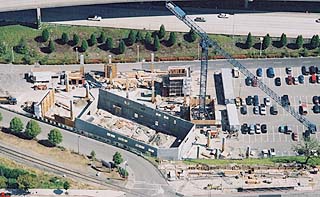|
Subscribe / Renew |
|
|
Contact Us |
|
| ► Subscribe to our Free Weekly Newsletter | |
| home | Welcome, sign in or click here to subscribe. | login |
Architecture & Engineering
| |
 |
May 1, 2003
Ethereal shapes belie a brawny base
Putnam Collins Scott Associates

Courtesy of Aequalis Photography
The Tacoma Art Museum galleries were built over a two-story concrete pedestal that houses the building’s administrative and support functions. |
For some buildings, the structural component plays a prominent role in the architectural expression. For others, the structure remains in the background, out of the way, rarely noticed.
But the Tacoma Art Museum plays it both ways — its straightforward concrete base structure gives way to sophisticated angular metal- and glass-clad shapes and spaces above.
Though the museum’s front door is on Pacific Avenue, its footprint is 25-30 feet below. The site’s steep slopes created an opportunity for the substructure to be completely different than the superstructure. The challenge was to support the museum structure as economically as possible 25 feet above grade, while providing administration space, museum-support services and parking below.
Early in the design process, the decision was made to maintain the steep slopes as much as possible so the new structure would not have to be designed to hold back the adjacent hillsides. Such a design would have resulted in large lateral soil pressure loads and increased construction costs.
Instead, the plan was to minimize spending on construction below Pacific Avenue. Costs were held in check by building a simple 140-by-63-foot, two-story concrete “pedestal” to the north and 12 concrete-column stilts to the south that were located to minimize disruption to the slopes. The museum’s main floor and plaza structure serve to bridge the concrete pedestal and the surrounding grade on Pacific Avenue.
The roughly 25-foot-tall concrete pedestal that houses the administrative and support functions was constructed with shotcrete walls and infill steel framing — a less-expensive option than traditional cast-in-place walls.
The shotcrete was “shot” in two lifts against a form on the inside face of the wall, which created an exposed exterior concrete finish that contrasts with the more refined structure above. The exposed concrete base only partially fills the large-volume space created below the superstructure that is used for parking, service access and the suspension of large mechanical units.
The superstructure is contained within the architectural forms it supports. An 80-foot-long, full-story, 16-foot-deep, steel truss is hidden within the south wall to allow the southeast corner to “hover” 25 feet above the ground below, cantilevering 40 feet in both directions.
A large steel beam contained within the lower roof ceiling space adjacent to the main lobby cantilevers to support the viewing corridor that “floats” above the lobby. A 10-by-84-foot steel roof truss supports the high roof on one side and the low roof on the other side. Steel glazing mullions support both “thin” roofs from above and “hung” roofs from below.
At the main gallery, the exterior wall does not appear to extend down to the floor. A horizontal “window slot” appears to interrupt the wall, giving it a floating feeling. The design required a structural header just a foot above the floor and careful coordination with ductwork to maximize the slot for light penetration.
The engineering challenge was to take all these shapes and tie them together to form a seismic-resisting system. Stepping and sloping floors and roofs, along with angular framing, support the gallery spaces that wind around the large open-air stone garden in the middle of the structure.
The design created numerous hot spots that collect and redistribute potential seismic loads to the superstructure’s steel-braced frames. Once the loads were collected into the braced frames and attached to the main floor level, they once again had to be collected and transferred to the concrete shear-wall pedestal structure below, which is roughly one-third the size of the footprint of the building above.
The support structure for the stone garden was designed to allow 250 pounds per square foot over some of the largest floor spans to accommodate the parking layout below.
Except for the exposed roof trusses in the main gallery, the superstructure is rarely seen. Yet, fitting the structure in and around the architectural shapes and spaces was an intense and successful collaboration of architect and structural engineer.
Dan Putnam, president of Putnam Collins Scott Associates, was principal-in-charge of the Tacoma Art Museum. His previous projects include the nearby Washington State History Museum and Chihuly Bridge of Glass.
Other Stories:


